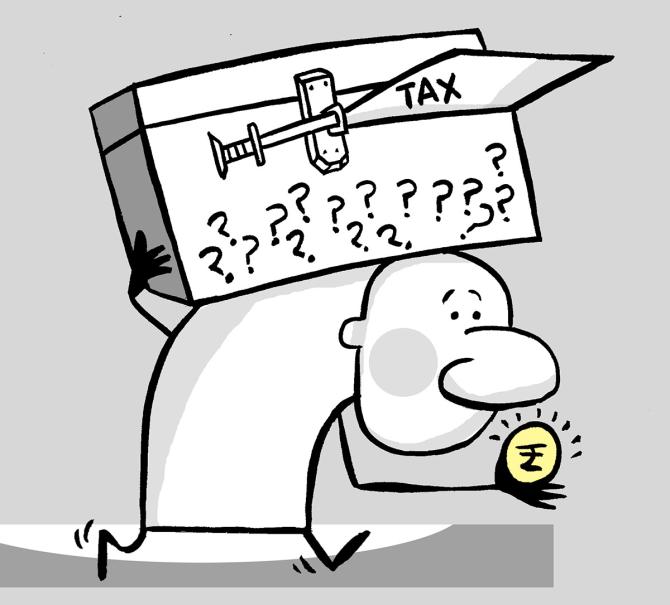7 states account for over 80 per cent of the total direct tax collections by the Union government.

Have more Indians come under the income-tax net over the last few years?
The latest data from the finance ministry's income tax department provides an answer to this question and points to many other interesting trends.
It also adds a perspective to the direction and effectiveness of the Union government's income-tax collection efforts since the formation of the Narendra D Modi government in May 2014.
Of course, the answer to the question raised above is categorically in the affirmative.
In 2013-2014, the last year of the Manmohan Singh government, an estimated 30.5 million individuals filed their tax returns.
Nine years later, in 2022-2023, that number rose to 69.7 million -- an increase of 128 per cent or a compound annual growth rate (CAGR) of close to 10 per cent.
Not bad at all. Even the personal income-tax collections grew from Rs 2.38 trillion to Rs 8.08 trillion in the same period -- notching up an increase of 239 per cent or an CAGR of over 14 per cent.
What can explain the difference between the rate of growth in the filing of tax returns and in the payment of income tax by individuals?
The detailed numbers released by the income tax department cover only the period up to the financial year 2021-2022.
According to this, over 89 million individuals paid income tax in 2021-2022, compared to 53.8 million in 2013-2014.
But the number of individuals who filed tax returns was only 65.46 million in 2021-2022 and 30.5 million in 2013-2014.
Clearly, the number of taxpayers is substantially higher than the number of individuals filing their tax returns.
The difference is as much as 23.54 million in 2021-2022 and 23.3 million in 2013-2014.
In between, the gap had widened to as high a level as 29 million in 2017-2018, but it stabilised at a lower level in subsequent years.
Officials explain that taxpayers are persons who have either filed a return of income or persons who have been subjected to tax deduction at source or TDS, but have not filed the return of income.
This would imply that over 23 to 29 million individuals have been paying taxes every year in the last few years through TDS but are not filing tax returns.
Two questions arise. One, has the government lost a huge opportunity in the last nine years in persuading well over 20 million taxpayers to file their returns and widen the tax base on a sustainable basis?
Remember that TDS accounted for about 45 per cent of the total direct tax collections in 2021-2022.
This share was lower at about 39 per cent in 2013-2014.
Even as TDS collections are rising, the growing number of individuals paying taxes through TDS but not filing returns is certainly a lost opportunity.
Collecting more tax through TDS is cost-effective for the government.
But that cannot be the reason for not converting those who are subjected to TDS into filers of regular tax returns.
The second question is: If indeed over 20 million taxpayers are not filing returns, what steps could the income tax department initiate to convert them into return filers?
Another way of looking at these numbers is to assess how different states have fared in contributing to overall direct tax collections by the Centre.
Just seven states have over the last few years accounted for over 80 per cent of the total direct tax collections by the Union government.
These are: Maharashtra, Delhi, Karnataka, Tamil Nadu, Gujarat, Andhra Pradesh and West Bengal.
While Maharashtra has maintained its position as the single largest contributor to the central direct taxes' kitty at 37 per cent, its growth over 2013-2014 at 129 per cent has been less than that of two other states.
Karnataka has recorded the fastest growth of 182 per cent in the first eight years of the Modi regime, followed by Gujarat at 148 per cent.
Delhi, Tamil Nadu and West Bengal just about managed to double their respective contribution, while Andhra Pradesh has been a laggard at just 78 per cent.

How states perform in terms of their contribution of direct taxes to the Centre indicates the pace of economic activity in them.
The fact that these seven states have continued to remain the source of over 80 per cent of the Centre's direct taxes reflects how India's economic activities have been largely concentrated in a few areas.
Companies tend to locate their headquarters in cities and state capitals, where they find doing business is easier.
This trend might favour established cities like Mumbai, Delhi and Bengaluru over other cities.
However, the share of personal income in total direct taxes is rising and the continued dominance of these seven states suggests that the spread of economic prosperity among people in other states has been limited.
The need for economic dispersal so that the fruits of development are shared by more states can hardly be overemphasised.
A noticeable change in the composition of direct taxes also cannot be missed in these numbers.
In 2013-2014, personal income-tax, at Rs 2.43 trillion, was less than two-thirds of corporation tax collection.
Nine years later, personal income-tax collection at Rs 8.08 trillion is almost the same as the corporation tax collection of Rs 8.25 trillion.
This is as significant as the gradual decline in the share of direct taxes in the Centre's gross tax collection over the last nine years.
Against about 56 per cent in 2013-2014, the share of direct taxes in total tax collection has been sliding to reach about 53 per cent in 2022-2023.
The most striking takeaway from the latest tax data pertains to the number of individual taxpayers in the country, whose gross annual income is over Rs 1 crore.
In 2013-2014, there were 48,416 such taxpayers.
In 2020-2021 (for which the latest data is available), this number rose to 132,497 -- a CAGR of over 15 per cent in these seven years.
Remember that 2020-2021 was the year when the Covid pandemic had devastated the economy.
Despite that, the number of those who earned over Rs 1 crore had increased, although at a lower rate of about 7 per cent, from 124,063 in 2019-2020.
Indeed, the first year of Covid saw not only an increase in the number of individuals filing returns to 63.7 million (up from 60 million in 2019-2020), but there was an increase in the number of individuals declaring gross income in most categories.
The exception was the low-income group earning Rs 2.5 lakh to Rs 4 lakh per annum, where the number of return filers declined by 1.65 million.
A part of this decline was perhaps offset by increases in the immediately higher income categories.
But even then, the fall was significant. A decline was also noticed in the high-income groups of those earning between Rs 10 crore and Rs 25 crore, between Rs 50 crore and Rs 100 crore, and above Rs 500 crore a year.
These tax numbers in a Covid year likely suggest that the impact of Covid was borne primarily by individuals in the unorganised sector outside the direct taxes net.
Individuals paying income tax were perhaps affected to a lesser degree.
But how bad Covid was for the tax-paying individuals' earnings will become clearer once the government releases the tax collections data for 2021-2022, when the full impact of the pandemic will be evident.
Feature Presentation: Aslam Hunani/Rediff.com











